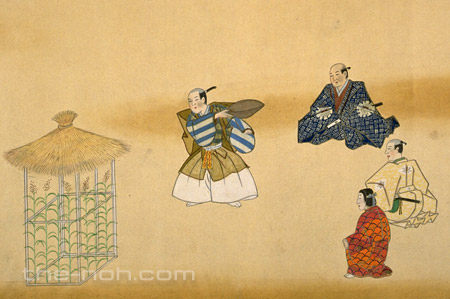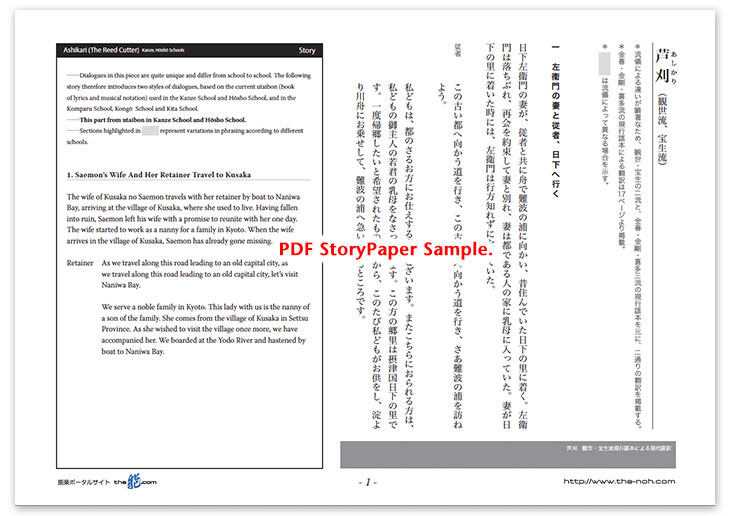
 Ashikari (The Reed Cutter)
Ashikari (The Reed Cutter)

![]()
The wife of Kusaka no Saemon lived in the village of Kusaka in Settsu Province, but after her husband’s family’s fortunes fell into ruin, she and her husband separated and she went to Kyoto. There, she started to serve as a nanny in the household of a nobleman. Since then, three years have passed. Having established a stable livelihood for herself in Kyoto, the wife returns to Kusaka village with a retainer in order to determine her husband’s whereabouts. The retainer asks a villager about her husband, but he does not know where the husband has gone. The wife, however, decides to stay in the village of Kusaka for a while, determined to find her husband.
To cheer her up, her retainer asks the villager if there is anything interesting to see in the area and is told about a peculiar man who cuts reeds to sell at the market on the beach. When the wife and retainer wait at the beach market, the reed cutter appears. While he laments his reduced status, he also describes the elegance of his work. Later, the man talks to the retainer and explains to him the two words that are different names for reeds. He then performs a dance while singing an amusing song, incorporating famous poems into its lyrics.
The wife tells her retainer to ask the man to bring her a reed stem. Although the man brings a reed to her, when he sees her, he hides in a hut. In fact, the reed cutter is her husband, Saemon. Realizing that she is his wife, he feels so ashamed that he hides in the hut. The wife persuades him that as she has established a stable livelihood in Kyoto, she has come to bring him back with her. She then asks him to show himself and come to her. The couple expresses their heartfelt emotions in poems that they exchange with each other. Now, Saemon believes he has nothing to hide and comes out from the hut. The retainer congratulates the couple on their reunion and encourages Saemon to come to Kyoto together with his wife. Saemon changes into an eboshi-headdress and hitatare-style kimono, lauds the virtue of poems, and dances with joy. The couple now travels together to springtime Kyoto.
![]()
This is a human drama that depicts the reunion and rebonding of a couple forced to separate by the decline of the family’s fortunes. Poems are cited frequently and play an important role, especially during the scene in which the couple reconfirm their love for each other. Overall, this drama lauds the virtue of poems. The subtle love between the couple is finely, delicately described by the backdrop of the Naniwa region in spring.
This play is distinguished by its elegantly flowing songs that incorporate the beautiful words of poems as well as by dances and movements performed to the lyrical rhythm of poetry, which keep the audience enthralled. For instance, there is the scene in which the lead character (shite), the reed seller, delivers a sophisticated commentary on the two names for reeds, comparing them to the words “good” and “bad;” the scene of the Sedge Rain Hat, in which the man performs a rhythmic song and dance to the words of poems praising the beauty of the spring in Naniwa; the scene in which the wife learns that the reed seller is Saemon and the couple exchanges poems expressing their heartfelt emotions upon being reunited; the scene of otoko-mai (a man’s dance), in which Saemon changes his attire into eboshi headdress and hitatare-style kimono and performs a manly dances expressing his gratitude; and finally, the last scene, in which the couple together depart for Kyoto. From one scene to the next, the subtle shifts, from moment to moment, in the characters’ emotions along with the changing scenery are finely portrayed in a splendid theatrical progression that will delight the eyes and ears of the audience.
STORY PAPER : Ashikari (The Reed Cutter)
Story Paper presents noh chant stories in modern speech, with story outlines, highlights and more using Adobe PDF format, which can print out and zoom in. Print out the pages and take them with you when you see the actual noh performance.

The copyright of Story Paper is held by the Noh.com. Story Paper is for individual use only. It is prohibited by the copyright law to distribute or publish printed-out Story Paper pages without prior consent. For more information, check the credit and disclaimer pages.



 [Ashikari (The Reed Cutter) : Story Paper PDF : 672KB
[Ashikari (The Reed Cutter) : Story Paper PDF : 672KB